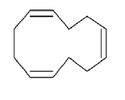Difference between revisions of "1,5,9 cyclododecatriene"
| Line 17: | Line 17: | ||
CDDT is used to produce [[cyclododecane]], which is used in the production of dodecanedioic acid. | CDDT is used to produce [[cyclododecane]], which is used in the production of dodecanedioic acid. | ||
| − | It has a high volatility, which causes it to have an aquatic half-life (by evaporation) of only 1,3 hours. In the atmosphere it will be degraded rapidly (in less than 30 minutes). As a consequence CDDT will be found mostly in soils, and very little in water, air or sediment. It however is considered not to be biodegradable and has a low tendency | + | It has a high volatility, which causes it to have an aquatic half-life (by evaporation) of only 1,3 hours. In the atmosphere it will be degraded rapidly (in less than 30 minutes). As a consequence CDDT will be found mostly in soils, and very little in water, air or sediment. It however is considered not to be biodegradable and has a low tendency to [[bioaccumulation|bioaccumulate]]. |
Aquatic concentrations above 0,2 mg/l cause acute toxicity to fish, algae and invertebrates. A dose of 2,5 g/kg body weight is lethal to rats. | Aquatic concentrations above 0,2 mg/l cause acute toxicity to fish, algae and invertebrates. A dose of 2,5 g/kg body weight is lethal to rats. | ||
Revision as of 11:05, 27 August 2009
Definition of 1,5,9-Cyclododecatriene (CDDT):
1,5,9-Cyclododecatriene is a liquid with a yellow tint and pungent odour. [1]
This is the common definition for 1,5,9-Cyclododecatriene (CDDT), other definitions can be discussed in the article
|
Notes
| 1,5,9 cyclododecatriene |
|---|

|
| Formula |
| C12H18 |
CDDT is used to produce cyclododecane, which is used in the production of dodecanedioic acid.
It has a high volatility, which causes it to have an aquatic half-life (by evaporation) of only 1,3 hours. In the atmosphere it will be degraded rapidly (in less than 30 minutes). As a consequence CDDT will be found mostly in soils, and very little in water, air or sediment. It however is considered not to be biodegradable and has a low tendency to bioaccumulate.
Aquatic concentrations above 0,2 mg/l cause acute toxicity to fish, algae and invertebrates. A dose of 2,5 g/kg body weight is lethal to rats.
Considering CDDT it is only used as an intermediate in the production of other chemicals, its high volatility and degradability, it has only a minor potential aquatic exposure and thus poses only a minor risk to aquatic organisms.[1]
Environmental standards and legislation
Included in the OSPAR list of substances of priority action